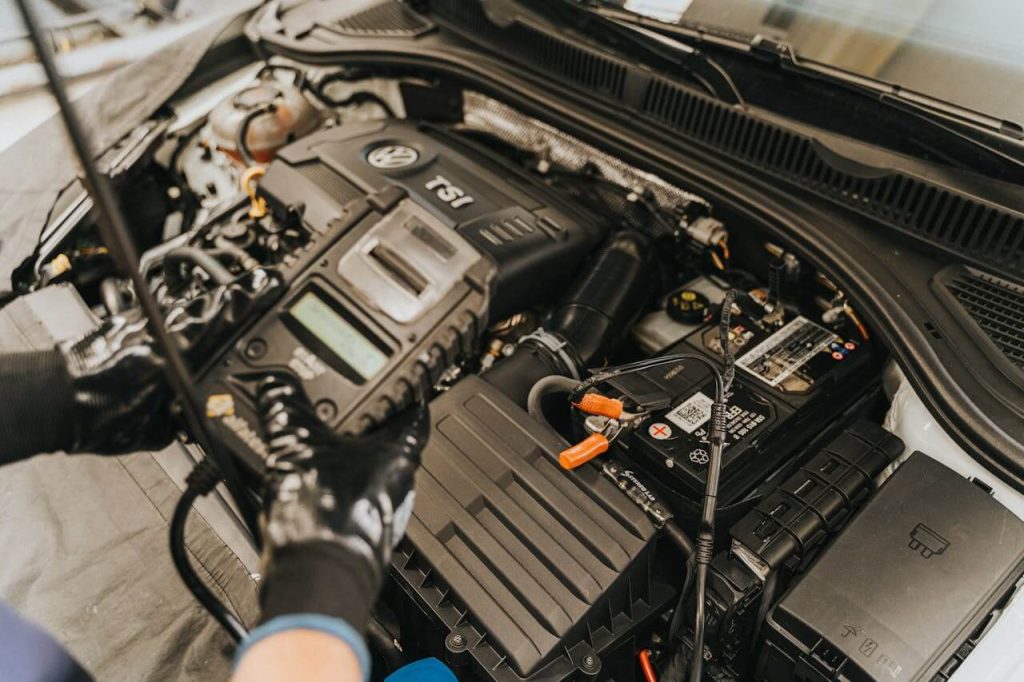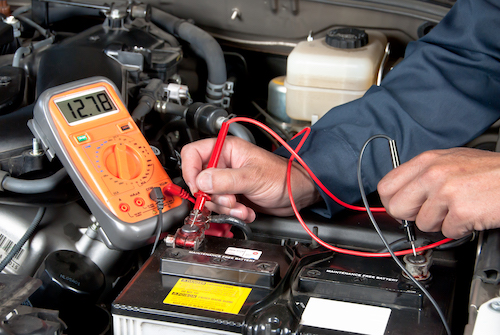
The car battery is the highest provider of power to your car’s electrical systems and will touch even the most silky smooth startups. The car’s power source, it sends electricity to the starter motor, lights, radio, and all other things that a car can give. When it goes bad, your car will be affected, thus good to know the early warning Signs Your Car Battery Needs Replacement. In this guide, we have temporarily dug a little bit deeper into the Signs Your Car Battery Needs Replacement, which gave you the insight of when to be active and how to maintain the reliability of your car.
Signs Your Car Battery Needs Replacement
1. Slow Engine Crank
The symptoms of slow engine crank manifest first most of the time a Signs Your Car Battery Needs Replacement. When the battery fails, it will lack ample power to supply the starter motor; hence, the ignition process becomes slow.
Understanding the Slow Crank
While turning the ignition key or depressing the start button, the engine turns over slowly or lingers over the usual amount of time it takes to crank up. This symptom is mostly bad during cold mornings since the battery’s natural efficiency has been decreased.
Why it occurs
- Batteries age and their holding capacity to a full charge diminishes
- Internal chemical reaction slows down as temperatures lower down due to extreme climates.
- Long-term use without maintenance leads to output deterioration.
Something to Do
- If this is happening to you more than once, have your battery checked immediately.
- The trouble with procrastinating on replacing a dead battery is total loss, which can leave you stranded and lost in a place and time with no friends or expertise.
2. Dashboard Warning Light
Modern cars have sophisticated monitoring sensors that scan various systems like the car battery. In most instances, it will Signs Your Car Battery Needs Replacement , and as such, you may see a dashboard warning light.
What does the warning light signify?
Here are the possible causes for a battery-shaped warning light being on:
- The voltage of the battery is low than the set value
- The alternator is not charging the battery correctly
- Corrosion or loose terminals will intervene in the power flow
Interpret the Warning
It doesn’t have to necessarily mean that the battery’s bad as it can be caused by a problem with the alternator, and sometimes even the wiring. To most car owners, though, this is one of the earliest Signs Your Car Battery Needs Replacement
How to Fix
- Don’t take lightly the warning light; get your mechanic to check it out.
- Ask for a load test for the battery and an alternator test to clarify the cause.
3. Flickering Headlights and Electrical Malfunctions
Most electrical components of your car-most notably, your headlights, lights inside, radio, and power windows- decouple pretty efficiently based on your car battery. The more the battery decays, the more these components will start acting strangely, and you’ll be led to Signs Your Car Battery Needs Replacement.
What to Look Out For
- Headlights dimming or when engine is idle but improve when you rev it
- Interior lights that flicker or won’t turn on
- Other accessory items in your car such as the radio, USB ports, and air conditioning also fail to function properly
Why This Happens
- A weak battery cannot supply enough power supply to the other parts
- Flickering or dimming occurs when electrical loads overwhelm what the remaining capacity of the battery can hold
How It Affects Your Car
Ignoring these warning signs will result in bigger electrical issues. A dead battery is also straining your alternator, and this may bring an increase in the cost for car repair.
What to Do
- Have your electrical systems checked.
- Replace the dead battery right away to avoid damaging other car parts.
4. Swollen Battery Case
A swollen or bulged battery case is a serious matter that requires to be attended as soon as possible. This is one of those obvious visual Signs Your Car Battery Needs Replacement.
Causes of Bulging
- Overcharging: A faulty alternator can cause the battery to overcharge. In this instance, it will create inner overheating and bulging.
- Excessive Heat and Freezing Conditions: In both cases, extreme heat or freezing conditions can cause damage to the structure of the internal parts of the battery.
- Chemical Breakdown: Worn out parts of the inner components could result in excessive formation of gases and deformation of the casing.
Risks Associated with a Swollen Battery
- The swollen battery may leak acid. The leakage of chemicals will damage the near components and create safety risks.
- It also increases the possibility of short circuits in the inner framework of the battery. This might lead to a fire hazard.
Steps to Take
- Never jump start or recharge a swollen battery.
- Dispose of the old battery safely and replace it with a new one.
5. You Have to Jump Start Frequently
If you are jumping your car frequently, then that is a sure Signs Your Car Battery Needs Replacement. Though it is usual to jump start your car sometimes due to lights having been left on or similar mistakes, repeated jump starting of your car may indicate that there is an issue deep down.
Why Jump Starting Becomes a Red Flag
- The internal wear inside the battery makes it unable to hold a charge.
- The excessive amount of sulfation on the battery plates does not enable sufficient recharging.
- Deterioration inside the alternator or electric system makes things worse
What is the Result of Jump-Starting Several Times
- Jumping over time overworks the alternator and the starter motor
- It results in early wear of other parts, bringing costly bills.
When to Replace the Battery: Signs Your Car Battery Needs Replacement
- If you have jumped-started more than two times in a month, its a Signs Your Car Battery Needs Replacement battery.
- Seek professional testing to confirm the battery cannot recharge.
Reasons That Shorten Battery Life
Understanding the reasons why car batteries fail will assist you in avoiding premature failure. Here are the most common reasons:
1. Age
- Car car batteries have an age duration that ranges between 3–5 years. If your battery undergoes this period, its capacity will begin to decline.
- Checking and inspecting your battery after three years will help detect early issues.
2. Weather Extremes
- Hot weather causes rapid loss of water in a battery, which eventually leads to losing electricity.
- Freezing temperatures slow down the chemical reaction needed to activate the battery, thus making it difficult to start the car.
3. Poor Maintenance
- Dirt on terminals or loose connections may lead to power delivery issues.
- Not regularly cleaning and inspecting the battery increases the risk of issues.
4. Short Travels
- Frequent short travels will mean that the alternator hasn’t totally charged the battery.
- Eventually, this results in sulphation and decreased capacity after a long period.
5. Parasitic Drains
- Leaving lights or accessories on drains the battery unnecessarily.
- The electrical issues such as bad wiring can also drain the car of its power when the engine is turned off.
How to Check for a Dead Battery
If you get the Signs Your Car Battery Needs Replacement or has reached the end and needs to be replaced, you should check for it before buying a new one. Here is how you do it:
1. Voltage Test
- The voltage test requires a multimeter.
- A good battery, when the car is off, will read 12.6 volts or higher.
2. Load Test
- A load tester measures how a battery holds voltage under simulated load.
- High voltage drop points to a weak battery
3. Professional Testing
- A mechanic uses more sophisticated testing equipment to test the battery and charging system
- They can tell if it is the problem with the battery, alternator, or some other electrical component
Extending Battery Life
Preventative maintenance on your battery can push back the Signs Your Car Battery Needs Replacement. Here are some in-the-trenches tips:

1. Clean It Periodically
- Try to remove corrosion that may be gathering on your terminals using baking soda and water.
- Apply a light grease to prevent this buildup again.
2. Not Completely Discharge It
- Do not allow the battery to drain to completely dead.
- Turn off your lights and accessories when the car is off.
3. Drive Regularly
- A series of drives will keep the alternator in operation, which recharges your battery.
- Steer away from stagnation
4. Parking under Ideal Conditions
- Try as much as possible to avoid parking your car in scorching or freezing temperatures for long
- Using a battery warmer in a cold climate for maximum effect
Selecting a Quality Replacement Battery
Once it is confirmed with the Signs Your Car Battery Needs Replacement. There are specific requirements a replacement battery should have to ensure optimal functionality.
Baseline Qualities:
- Size and Fit: Matching measurements and position of the terminals based on the car’s specifications.
- Cold Cranking Amps (CCA): Make sure that the car will have enough power to start when the battery is being started in cold.
- Reserve Capacity (RC): Batteries with a high RC can give over- load power as long as possible when you are off and the alternator is out.
- Warranty: Select batteries that go on for a longer warranty period with peace of mind.
Top Brands:
- Exide- Though durability long, and more performance are a few features known through its dint.
- Amaron- Reliable, long-life offers different options
- Bosch- Technology advancement with superior build
Conclusion
Recognizing these 5 Signs Your Car Battery Needs Replacement will save you from nasty breakdowns and over-the-top repair bills. This can include the cranking of your engine, dead headlights, or a motor frequently jump-started. These are not the symptoms you want to ignore, and proactive maintenance and timely replacement are the keys to keeping your car moving smoothly.
Therefore, you can protect other vehicle components and safe you from being stranded while traveling by car through timely action when you get the Signs Your Car Battery Needs Replacement. From these Signs Your Car Battery Needs Replacement, by understanding and taking the above preventative measures, you will maximize the lifespan of your battery as well as the overall reliability of your car. You can check other guide to know How to choose the right tyre for your car.